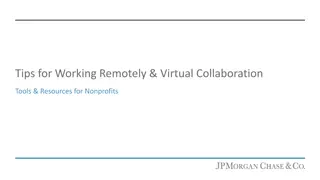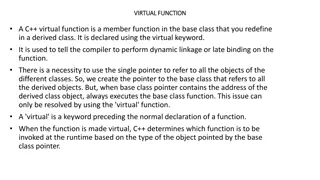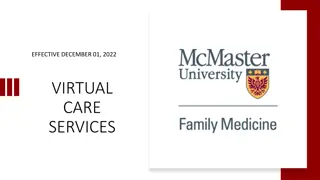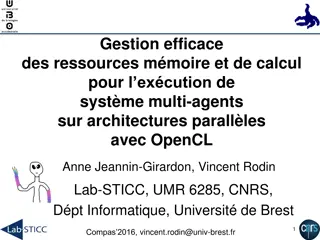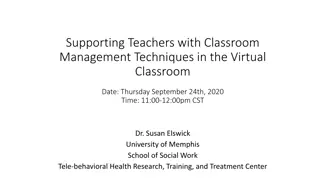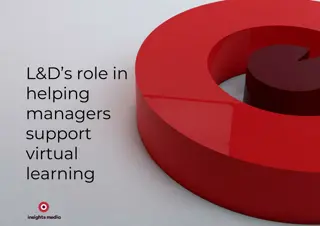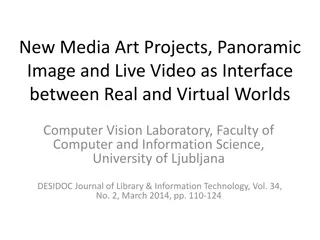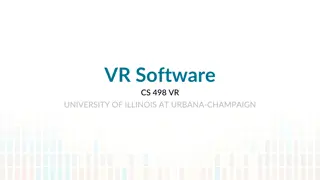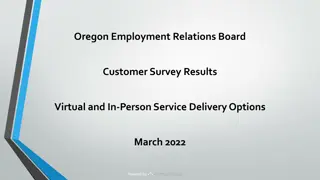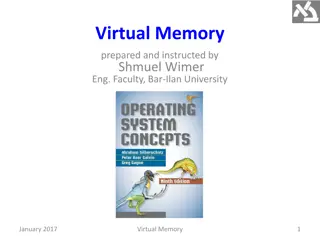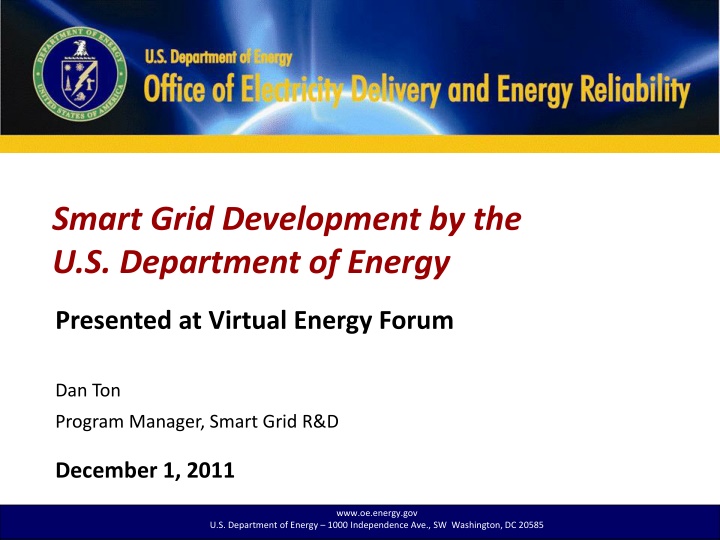
Advanced Smart Grid Development and Technology Overview
Explore the U.S. Department of Energy's Smart Grid development initiative, including its goals, assets, applications, values, and barriers. Discover the key technology areas, mapping of assets, and value creation in the 21st-century Smart Grid era. Learn about the DOE's programs, recovery act focus areas, and international coordination efforts for Smart Grid advancement.
Download Presentation

Please find below an Image/Link to download the presentation.
The content on the website is provided AS IS for your information and personal use only. It may not be sold, licensed, or shared on other websites without obtaining consent from the author. If you encounter any issues during the download, it is possible that the publisher has removed the file from their server.
You are allowed to download the files provided on this website for personal or commercial use, subject to the condition that they are used lawfully. All files are the property of their respective owners.
The content on the website is provided AS IS for your information and personal use only. It may not be sold, licensed, or shared on other websites without obtaining consent from the author.
E N D
Presentation Transcript
Smart Grid Development by the U.S. Department of Energy Presented at Virtual Energy Forum Dan Ton Program Manager, Smart Grid R&D December 1, 2011 www.oe.energy.gov 3/21/2025 1 December 2008 National Academy of Engineering - BMED U.S. Department of Energy 1000 Independence Ave., SW Washington, DC 20585
Presentation Outline Overview of Smart Grid Definition, Goals, Assets, Applications, Values, Barriers DOE Programs Addressing Smart Grid Barriers Recovery Act Grid Modernization Focus Areas DOE Smart Grid R&D Program International Smart Grid Coordination and Collaboration December 2008 2
Smart Grid: What is it? DOE has defined seven core Smart Grid characteristics The Smart Grid Initiative is to develop and implement advanced information, communication, and control technologies, along with supportive policies, to achieve all seven characteristics. December 2008 3
Smart Grid Technology Areas December 2008 4 4
Mapping of Smart Grid Assets (Components), Applications, and Technology Areas technology areas manage peak load wholesale operations Applications ancillary services integrate renewables enhance reliability efficiency & carbon PMUs EVs & PHEVs Smart Meters Comm. Networks Business Systems DR DG DS DA/FA* Primary Assets Enabling Assets December 2008 * DA/FA: Distribution automation/feeder automation 5
Assets + Applications Value Creation 21 21st stCentury Smart Grid Century Smart Grid 21 21st stCentury Smart Grid Century Smart Grid Highly Highly Grid Self- Optimization Optimization Grid Self- End-to-End Automation Automation End-to-End Clean Resource Optimization Optimization Clean Resource Automated Automated Efficiency Efficiency Differentiated Reliability Reliability Differentiated Online Energy Efficiency & Management Management Online Energy Efficiency & Demand Management Management Demand Distribution Distribution Automation Automation Electric Vehicle Management Management Electric Vehicle Local Power Parks Parks Local Power visibility visibility control control Advanced Metering Metering Advanced Distributed Renewables Renewables Distributed Load Load Emergency Power Power Emergency EE Programs EE Programs Curtailment Curtailment Power Quality & Power Quality & Power Quality & Power Quality & Reliability Reliability Reliability Reliability Operational Operational Efficiency Efficiency Efficiency Efficiency Operational Operational Clean Clean Technology Technology Technology Technology Clean Clean Capacity Capacity Capacity Capacity Energy Efficiency Energy Efficiency Energy Efficiency Energy Efficiency Foundation / Infrastructure Foundation / Infrastructure Foundation / Infrastructure Foundation / Infrastructure December 2008 6
Barriers to a Smart Grid Businesses, state regulators, and consumer advocates are unconvinced of the value of smart grid technologies due to lack of performance data on costs and benefits Insufficient or inadequate technologies, components, and systems to leverage IT potential of smart grid No established standards for interoperability of systems and components Insufficient cyber security for a smart grid architecture Lack of a skilled workforce to build, install, operate, and maintain systems and equipment Consumer understanding of the electrical infrastructure and opportunities enabled by smart grid technologies December 2008 7
OE Program Addresses Key Barriers Barriers to Smart Grid Inadequate Technologies & Components No Insufficient Cyber Security Lack of a Skilled Workforce Uninformed Consumers Lack of a Strong Business Case Standards for Interoperability Smart Grid Stakeholder Books Federal Smart Grid Task Force Smart Grid Websites Stakeholder Engagement Process Smart Grid R&D Energy Storage R&D Clean Energy Transmission Reliability Smart Grid Development DOE EERE Programs DOE ARPA-E DOD Spiders Cyber Security For Energy Delivery Smart Grid Investment Grants OE Activities Workforce Training Development Grants Interoperability Standards Smartgrid.gov Infrastructure Security and Energy Restoration Smart Grid Demonstration Program Smart Grid Information Clearinghouse Other Activities NARUC State Training - California - Arkansas - Colorado - Wyoming - Northern Plains and Rocky Mtn Consortium Utility Programs DHS S&T EPRI NIST FERC DHS NCSD APPA FERC SmartGrid Consumer Collaborative NIST NIST NRECA EPRI ISGAN PSERC DOD Spiders Smart Response Collaborative The Galvin Initiative NERC NARUC December 2008 8
Recovery Act Grid Modernization Focus Areas December 2008 9
Recovery Act Grid Modernization Programs created by statute Energy Infrastructure Security Act 2007: Smart Grid Investment Grants (Sec. 1306) Smart Grid Regional Demonstrations (Sec.1304) One-time Appropriation, $4.5B in ARRA funds $620M for demonstration projects $3.425B for deployment projects Resource Assessment & Transmission Planning Smart Grid Interoperability Standards Recovery Act Directed Programs: Workforce Training - $100M Interconnection-wide Transmission Planning and Resource Analysis - $80M Interoperability Standards - $12M CA 419 Other Workforce Training Top 10 States by Total Awarded Smart Grid Demos State Amt ($M) NC 434 Investment Grants TX 293 NY 276 Additional OE initiatives FL 270 State & Local Energy Assurance State Regulatory Assistance PA 265 MD 233 DC 213 $4.5 billion obligatedby end of FY10 $1.6 billion paid out to date AL 166 December 2008 OH 146 10
Recovery Act Grid Modernization Goals Deployment of Smart Grid Technologies 15.5 million smart meters 800 Phasor Measurement Units 6,500 Distributed Circuits Reductions in monthly bills for customers with smart meters and enabling technologies Reductions in peak demand translate to less generation capacity required Reductions in operating costs for distribution circuits with automated equipment Economic Benefits Reduction in length of power outages Reduction in frequency and geographic scope of power outages Reliability Benefits Environmental Benefits Reductions in energy wasted (line losses) in distribution circuits Reduced emissions of CO2, NOX, and SOXassociated with electricity consumption of customers with smart meters and enabling technologies December 2008 11
Smart Grid Investment Grants (SGIG) Number of Projects Selected Projects Total Funding $7,863,897,259 Large Projects, 25 (25.3%) Federal Share $3,425,938,323 Total Number of Projects 99 Small Projects, 74 (74.7%) Deployment of current technological components for immediate commercial use Support of manufacturing, purchasing, and installation of smart grid technologies Large projects: $20M-$200M Small projects: $394K-$20M (Federal share) 3-year projects SGIG Recipient Types Tech/ Manufac- turing Co., 4% Irrigation District, 1.0% Electric Co-ops, 17% ISO/TO, 9.0% Municipal Utilities, 29% IOU, 39% December 2008 12
Smart Grid Demonstration Program (SGDP) Number of Projects Selected Projects Total Funding $1,647,637,256 Total Federal Funding $620,027,274 Large Projects, 12 (37%) Total Number of Projects 32 Small Projects, 20 (63%) Demonstrate emerging technologies (including energy storage) and alternative architectures Validate business models Address regulatory and scalability issues Large projects: $20M-$89M Small projects: $720K-$20M (Federal share) 4-year projects (average) SGDP Recipient Types Electric Co- ops, 3.0% Municipal Utilities, 13% Technology / Manufac- turing Company, 34.0% IOU, 41% December 2008 13 Non-Profit, 9%
Distribution of Projects by Technology 131 total projects in the SGIG and SGDP programs, with some projects installing multiple technologies 76 80 70 65 60 Number of Projects 50 40 27 30 20 11 10 2 0 AMI DA PMU Storage Equip. Mfg. December 200814
Distribution of AMI Projects & Customer Engagement 76 projects have AMI and some type of customer program, most being pilot activities engaging a limited segment initially 70 59 56 60 Number of Projects 50 36 40 30 20 10 0 "Time-Based Rate" Pricing Programs Customer Devices Direct Load Control Note: Project components are NOT mutually exclusive December 200815
SGIG: Distribution Automation Distribution Automation Function 50 45 Number of Projects 45 37 40 35 29 28 26 30 22 25 20 15 15 9 10 5 0 December 200816
Recovery Act - Transmission $308M ($153M Federal) dedicated to 10 Transmission Projects American Transmission Company (PMU) American Transmission Company (SCADA) Duke Energy Carolinas Entergy Services Midwest Energy Midwest ISO 9 transmission utility partners ISO New England 7 transmission utility partners New York ISO 8 transmission utility partners PJM Interconnection 12 transmission utility partners Western Electricity Coordinating Council 18 transmission utility partners By 2013, over 900 networked phasor measurement units (PMUs) will be installed, providing nearly complete coverage of the transmission system. December 2008 17
Recovery Act PMU Deployment The SGIG program is supporting the deployment of 804 phasor measurement units (PMUs) across the US. ATC 48 PMUs NYISO 39 PMUs ISO-NE 30 PMUs WECC 250 PMUs PJM MISO 150 PMUs 81 PMUs Duke Energy Carolinas 102 PMUs Midwest Energy 21 PMUs SGIG Total 804 PMUs Entergy 38 PMUs FPL 45 PMUs Source: Map from North American Synchrophasor Initiative, 2009 December 2008 18
Recovery Act - Energy Storage $586 million in private investment from $185 million in federal funds Better than 3:1 Energy Storage Regional Demonstration Projects Include Large Battery Systems (3 projects, 53MW) Compressed Air (2 projects, 450MW) Frequency Regulation (20MW) Distributed Projects (5 projects, 9MW) Technology Development (5 projects) 20 Li-Ion community energy storage units on Detroit Edison grid December 2008 19
Recovery Act - Transmission Planning Consensus scenarios for future electricity supplies and analyzing environmental and other considerations that will be incorporated into transmission plans Long-term resource and transmission planning studies in 2011, with update in 2013 The knowledge and perspective gained from this work will inform policy and regulatory decisions in the years to come and provide critical information to electricity industry planners, states, and others to develop a modernized, low-carbon electricity system Time horizon expanded to 20 years for planning First time environmental stakeholders included in process December 2008 20
Recovery Act - Workforce Training Recipients of the Recovery Act funds will provide training in demand response, distributed generation, energy utilization/optimization, and cost simulations. $100 million in Recovery Act funds was being offered to 54 workforce training programs. Target benefits include: Up to 175,000 technicians, staff, and management positions filled with qualified personnel Skilled workforce educated in energy conservation and renewable energy Increased investment in advanced laboratory equipment, faculty development, and academic research Increased skills and pay rates for technicians and displaced workers Increased awareness of cybersecurity issues December 2008 21
Smart Grid Benefit Analysis: DOE Smart Grid Computational Tool (SGCT) The SGCT is an analysis tool that identifies the benefits of a SG project and guides the user through an analysis which quantifies those benefits. The SGCT characterizes smart grid (SG) projects by identifying what technology will be installed and what functionality that technology will enable. Based on the characterization of a project, it identifies the economic, reliability, environmental, and security benefits the SG project will yield. The SGCT uses user-entered data to calculate the monetary value of benefits and prepares graphs and tables that compare the costs and benefits to help determine the project s overall value. The SGCT can also perform a sensitivity analysis. December 2008 22
The SGCT can calculate the value of specific benefits* Benefit Category Benefit Sub-category Benefit Optimized Generator Operation (utility/ratepayer) Deferred Generation Capacity Investments (utility/ratepayer) Reduced Ancillary Service Cost (utility/ratepayer) Reduced Congestion Cost (utility/ratepayer) Deferred Transmission Capacity Investments (utility/ratepayer) Deferred Distribution Capacity Investments (utility/ratepayer) Reduced Equipment Failures (utility/ratepayer) Reduced Distribution Equipment Maintenance Cost (utility/ratepayer) Reduced Distribution Operations Cost (utility/ratepayer) Reduced Meter Reading Cost (utility/ratepayer) Reduced Electricity Theft (utility/ratepayer) Reduced Electricity Losses (utility/ratepayer) Improved Asset Utilization T&D Capital Savings Economic T&D O&M Savings Theft Reduction Energy Efficiency Electricity Cost Savings Reduced Electricity Cost (consumer) Reduced Sustained Outages (consumer) Reduced Major Outages (consumer) Reduced Restoration Cost (utility/ratepayer) Reduced Momentary Outages (consumer) Reduced Sags and Swells (consumer) Reduced Carbon Dioxide Emissions (society) Reduced SOX, NOX, and PM-10 Emissions (society) Reduced Oil Usage (society) Reduced Wide-scale Blackouts (society) Power Interruptions Reliability Power Quality Environmental Air Emissions Security Energy Security December 2008 23 *Methodological Approach for Estimating the Benefits and Costs of Smart Grid Demonstration Projects, EPRI, January 2010.
Smart Grid R&D Program December 2008 24
Smart Grid R&D Program Dollars in Thousands R&D Areas Guided by MYPP* on: Renewable & distributed systems integration Microgrids Integration of Plug-in Electric Vehicles (PEVs) Modeling & Analysis Advanced communications & controls Foundational standards and best practices Demand response and consumer acceptance FY 2011 FY 2012 Planning 23,000 20,000 Promotes the development of an efficient, fully integrated smart grid through the adaptation and integration of digital information and communication technologies into the Nation s electricity delivery system. * MYPP available at: http://www.smartgrid.gov/sites/default/files/oe_mypp.pdf December 2008 25
Smart Grid Characteristics and R&D Program Goals 7 Characteristics Customer Participation Integrate All Generation & Storage Options New Markets and Operations Asset Optimization and Operational Efficiency Power Quality for 21st Century Self Healing Resilient against Attacks and Disasters Long-term Goals Self-healing Distribution Grid for Improved Reliability Integration of DER/DR/PEV for Improved System Efficiency 2020 Targets 20% SAIDI reduction in distribution outages >98% reduction in outage time of required loads 20% load-factor improvement December 2008 26
Renewable and Distributed Systems Integration (RDSI) Lower Peak Demand Reduces Infrastructure Investments 9 demonstration projects in 8 states to integrate use of DER to provide at least 15% peak demand reduction on distribution feeder or substation Projects are either microgrids or are developing technologies that will advance microgrids Systems must be capable of operating in both grid parallel and islanded modes $55 million of DOE funds over five years (total value of awards will exceed $100 million, including participant cost share) 100% 90% 80% 75% Load Factor (%) 60% 40% 5% = ~400 hrs/yr 20% 0% 0% 20% 40% 60% 80% 100% 5% Percentage of Year Electric Generation Distribution Asset 25% of distribution & 10% of generation assets (transmission is similar), worth 100s of billions of US dollars, are needed less than 400 hrs/year! December 2008 27
PEV Integration FY 2011 Smart Grid-Capable EVSE FOA Reduce current costs of commercially available EVSE (residential and non-residential), with smart grid capabilities, by 50% in 3 years Key features: Bi-directional communications; Human machine interface for applications to provide local user input/output; PEV load management & smart controls; Conformance to interoperability, cyber security, and safety standards Source: Transforming Global Markets for Clean Energy Products, IEA (2010) Announcement of selections for award pending December 2008 28
Distribution Automation FY 2010 FOA Awards Advanced Communications and Controls On-Ramp Wireless: Develop a wide area wireless distribution grid sensor and faulted circuit indicator system capable of monitoring underground and other hard to reach distribution circuits ABB: Develop a real-time distribution feeder performance monitoring, advisory control, and health management system for enhanced asset utilization and grid reliability Integrated Distribution Management System Seamless integration of AMI & demand response, customer-owned DER, fault location, isolation, & restoration, volt/VAR control, & dynamic reconfiguration for distribution automation Boeing Distribution Management System Alstom s e-terra integrated distribution management system December 2008 29
CERTS Microgrid Test Bed Objective Expand CERTS Microgrid concepts to address system integration challenges presented by need to accommodate intermittent, distributed renewable electricity sources within utility distribution systems. Technical Scope The CERTS Microgrid Test Bed is being expanded through the addition of new hardware elements: (1) a CERTS compatible conventional synchronous generator; (2) a more flexible energy management system for dispatch; (3) intelligent load shedding; (4) a commercially available, stand-alone electricity storage device with CERTS controls; and (5) a PV emulator and inverter with CERTS controls. The concepts are explored initially through detailed simulation and bench-scale tests at UW and then demonstrated at full-scale using the CERTS Microgrid Test Bed operated by American Electric Power in Groveport, OH. December 2008 30
National Lab Team on SPIDERS (Smart Power Infrastructure Demonstration for Energy, Reliability, and Security) Cyber Security (INL) Virtual Secure Enclave Live Action Network Secure Distributed Monitors Situational Awareness Microgrid (SNL) Dynamic Control (SNL, ORNL) Load Control Systems Islanding Control System Energy Management System Seamless Grid Synchronization Advanced Metering Infrastructure Substation & Distribution Automation Two-Way Communications & Control Adaptive Relaying Assistant Technical Manager (SNL) Assistant Transition Manager (PNNL) Energy Secure Installation Demand Side Management (NREL, ORNL) Energy Efficiency Technologies Dynamic Voltage Regulators Smart Sockets Automated Load Shedding Renewable Integration (NREL) Photovoltaic Wind Fuel Cells Biofuel Energy Storage (NREL) Vehicle-to-Grid Hydrogen Batteries Operational Test Agency (PNNL) December 2008 31
Smart Grid Interconnection & Interoperability Standards In close work with the NIST Smart Grid Interoperability Standards Program Interoperability & Interconnection Standards GridWise Architecture Council Develop and disseminate smart grid interoperability related methods, tools, and education Leadership and participation in the NIST Smart Grid Interoperability Panel Annual Grid-Interop forums on smart grid interoperability IEEE P2030 Series: Smart Grid Interoperability development of interoperability Guides for smart grid components and the overall system IEEE 1547 Series of Interconnection Standards - development and harmonization of Interconnection and integration standards for DER Interoperability Conformance Testing: Establish test procedures and capabilities December 2008 32
Information Resources Smart Grid Information Clearinghouse Smartgrid.gov o Smart grid project summaries (with focus on non-ARRA projects), use cases, and business cases for the U.S. and internationally o >200 & >50 smart grid projects in the U.S. and overseas; >1,000 smart grid-related documents and multimedia (use cases, c/b analyses, business cases, legislation & regulation, standards, and technologies) o ARRA smart grid project summaries and other Federal program activities o Reporting of ARRA SGIG & SGDP projects (progress, metrics and benefits, consumer behavior studies) and provision of analysis results to the public December 2008 33
International Smart Grid Coordination & Collaboration December 2008 34
International Smart Grid Action Network (ISGAN) Bringing high-level government attention and action to accelerate world-wide development and deployment of smarter electricity grids ISGAN Facilitates dynamic knowledge sharing, technical assistance, peer review and, where appropriate, project coordination Sponsors activities that accelerate smart grid deployment and address knowledge gaps Builds on the momentum of and knowledge created by the substantial investments being made in smarter grids globally Fulfills a key recommendation in the Smart Grids Tech. Action Plan Leverages cooperation with the International Energy Agency, Global Smart Grid Federation, and other relevant stakeholders December 2008 35
ISGAN Scope December 2008 36
Four Foundational Projects 1 Global Smart Grid Inventory of enabling programs and policies Recognized that ISGAN is not the only entity developing an inventory Several such efforts underway regionally ENARD Annex V ASGI EEGI EC-directed (JRC) Etc. 2 Smart Grid Case Studies using a common framework and metrics Benefit/Cost Methodologies (bottom-up & top-down) and related policy toolkits to assess smart grid investments 3 Although different drivers for each, there are opportunities for cooperation Synthesis of Insights for High-level Decision Makers (e.g., CEM Ministers) from ISGAN and other related projects 4 December 2008 37
Others Projects and Collaboration Proposed or Under Consideration Smart Grid International Research Facility Network (SIRFN) Coordination with the ENARD IA (Electricity Networks, Analysis, Research & Development) Continuing dialog with private sector and other stakeholders (e.g., Global Smart Grid Federation, ADB, SGIP) Engagement with other international efforts (e.g., the US-EU Energy Council and APEC Smart Grid Initiative) Joint Projects with the DSM IA December 2008 38
Contact Information Dan T. Ton Program Manager, Smart Grid R&D Office of Electricity Delivery and Energy Reliability U.S. Department of Energy (202) 586-4618 Dan.ton@hq.doe.gov For more information: OE:www.oe.energy.gov Smart Grid:smartgrid.gov December 2008 39





